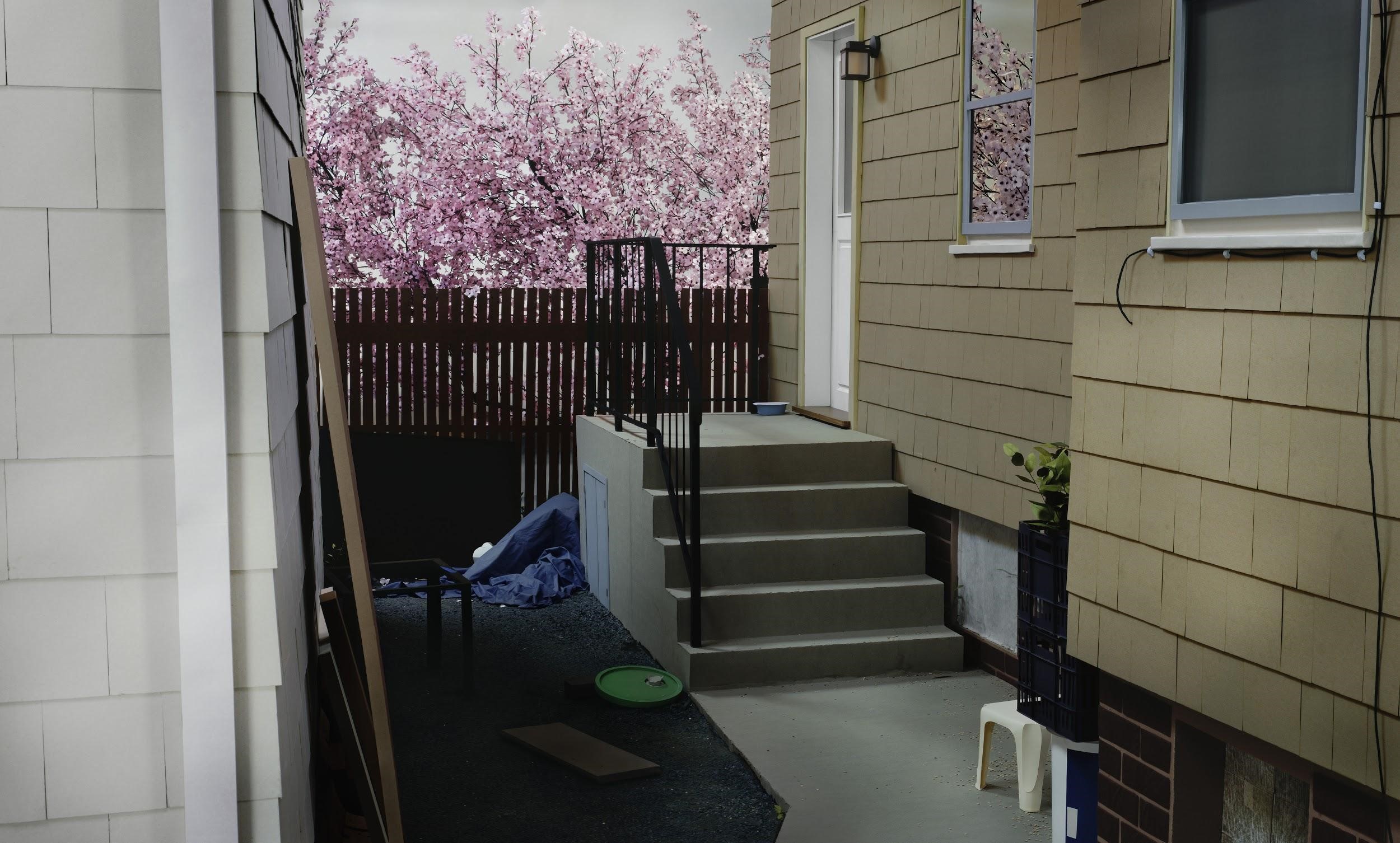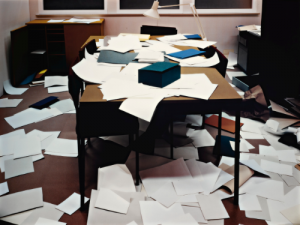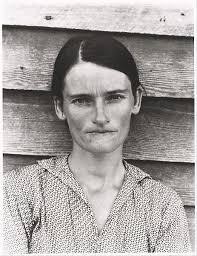The Deceptions of Thomas Demand

Thomas Demand has become, in the last 25 years or so, one of the more important contemporary artists in the world. His work is collected by all the major museums and sold in prestigious galleries and at art fairs. Eminent critic and art historian Michael Fried, among others, has directed serious attention to his work. Born in Germany in 1964, Demand went to school at the Kunstakademie Düsseldorf and then Goldsmiths College in London, where he imagined himself mostly a sculptor. But he soon turned toward photography. It is his photographs that have made him famous. But your first glance at a Thomas Demand photograph might very well leave you wondering what all the fuss is about.
Above is a typical picture by Thomas Demand. It is titled Backyard. That title might lead us to expect an expansive and grassy scene. But no, this is a cramped strip of concrete and plastic siding between two nondescript homes in a nameless neighborhood of Anywheresville, USA or, for that matter, Anywheresville, anywhere. There is a pile of blue vinyl behind the concrete stairs that lead up to the backdoor of one of the homes. The blue vinyl looks like the deflated remains of a kiddie pool that, in better weather, might provide whatever “outdoor fun” is to be had in this anemic backyard. The only element of beauty or hope in this outwardly mundane picture is the flowering trees (are they cherry blossoms?) in the background, the blooms reflected also in the window at the side of the house. But the flowers are held at a distance by the wooden fence that stands between us and them. The barrier feels significant. Spring may come and go, but its bounty will never truly penetrate the forlorn, plastic monotony of this “backyard.”
It should be mentioned that Backyard is a huge C-Print (91 X 150 inches) mounted on plexiglass and without any frame. The mundanity of the image is therefore partially offset by its commanding presence. Looking at the large, high resolution image, one can study the details of the scene. A few minutes of such study generally creates a sense of unease in the viewer. Something is wrong here. The problem is not so much in the overall content of the scene, or in its composition. Rather, many of the details in the picture just don’t look right. There are, for instance, several small pieces of dirt and refuse on the concrete steps that lead up to the door of the house on the right of the picture. But the bits of dirt do not look like real dirt. The dirt just isn’t dirty enough to be real dirt. Nor, at second glance, is the concrete rough and heavy enough in its appearance to be real concrete. And the light – the illumination on the steps doesn’t seem at all consistent with the overcast sky, just beyond those blossoming trees.
The secret is that Backyard is not a photograph of a real backyard at all. It is a photograph of a “fake” backyard, a life-sized model of a backyard made by Demand out of paper and cardboard. Even the beautifully flowering trees in the background are paper models. The plastic is not plastic, it is colored cardboard. Every single object in the picture has been constructed by Demand (and his assistants), which he then photographed. After the photograph was taken, the cardboard and paper model was destroyed. So, the photograph is the only documentation of the existence of this backyard. It was merely a “backyard” made from paper for the sole purpose of taking a picture that looks, sort of, like a backyard. The result is a picture of a backyard that creates a sense of puzzlement, a state of metaphysical uncertainty as to the true nature of the scene. Backyard is, in short, a picture of a scene that pretends to be real but that wants us to figure out is not.
And there’s more. It also turns out that this backyard is anything but a nondescript, Anywheresville, backyard. This backyard is a quite specific backyard. It is the backyard of Tamerlan Tsarnaev. Tamerlan Tsarnaev is the man who, along with his brother Dzhokhar, detonated homemade bombs at the Boston Marathon in 2013, killing three and wounding more than two hundred others. Tamerlan was himself killed in a shootout with the police later that same day. His brother Dzhokhar is currently on death row.
The photograph that Thomas Demand used as the basis for his paper model is actually a photograph of Katherine Tsarnaev, Tamerlan’s wife. She was mobbed by photographers coming out of her back door just after the identities of the Boston Bombers were revealed. The photograph was run in various newspapers and then shared virally across the web. Katherine is dressed completely in black and wearing a hijab. The actual backyard in the press photograph looks more or less as it does in Demand’s reconstruction, though it is grimier and more cluttered. The most notable omission in Demand’s version of the picture is Katherine herself. The reason for this omission is obvious. A cardboard model of a person would be immediately detectable as such and would ruin the first-glance authenticity of the model. Thus, we have with Backyard the photograph of a model of an original press photograph minus the one key figure, Katherine Tsarnaev, who was the subject of the original photograph. What seemed a simple, even boring, photograph turns out to be anything but.
Indeed, in the process of looking at this picture, we’ve gone from seeing what we thought was a mundane depiction of an everyday scene, to realizing that the scene is, in fact, a paper and cardboard fabrication of an otherwise mundane scene, to realizing further that this is the photograph of a model of what is, in essence, the scene of a crime or, at the very least, the scene of the aftermath of a crime. To add to the intrigue, Katherine Tsarnaev (née Russell) was something of an object of mystery and uncertainty herself. Did she have foreknowledge of the bombing? Had she been radicalized along with the brothers Tsarnaev? How did this woman from Texas end up marrying a Chechen boxer and converting to Islam?
The specifics of this drama are obscured by Demand’s removal of the human subject. Hidden under the surface of this photograph is a wealth of content. It is a picture that holds its trauma in reserve, dispensing it slowly as the viewer uncovers the many layers of what seemed, at first, to be the flattest of images.
Thomas Demand has produced an oeuvre of photographs that work more or less according to this same logic. Office (1995), for example, is the photograph of what looks to be a rather messy office, with paper strewn on desks and across the floor. Further inspection, however, reveals that all the papers and folders and documents in the room are completely blank. As with Backyard, this is actually a photograph of a life-sized paper and cardboard model of an original picture. The original picture (published in the German newspaper Der Spiegel) is of a room at the Stasi headquarters in Berlin just after the fall of the Berlin Wall in 1990. The office is a mess because people had just stormed in, tearing the place apart looking for the files that the East German Secret Police had been keeping on them up to the time the regime fell.
Küche / Kitchen, 2004, C-Print/ Diasec, 133 x 165 cm © Thomas Demand, VG Bild-Kunst, Bonn / ARS, New York
Or take Kitchen from 2004. This photograph seems to depict a modest kitchen, perhaps in a cramped apartment in one of those cities where space is at a premium. A small stove is crammed between a shelf on the left and a tiny cluttered sink on the right. Yet this picture, too, reveals the telltale signs of fabrication. The aluminum sink, for instance, doesn’t quite convey that specific metallic shine we’re expecting. It can’t, since it is made of shiny paper. The model, it turns out, is the reconstruction of a picture of the kitchen in Tikrit used by Saddam Hussein just before his capture by American forces in 2003.
There is something inherently intriguing, it’s safe to say, about the process of discovery that goes along with exploring a photograph by Thomas Demand. It is exciting, the kind of excitement that goes along with detective work or with any act of revelation. And there is something delightful about the models. Perhaps it is impossible to say exactly why. But as intrigued as we are by these pictures, we are nevertheless left wondering what exactly Demand is up to. Why does he do it? As with any significant work of art, this question cannot be answered definitively or exhaustively. This is as it should be. Works of art remain stimulating insofar as they resist complete explanation. There is, however, a context in which we can place Demand’s project. From within this context, the strategies for image-making that Demand employs become at least a little easier to understand and appreciate.
The context I’m referring to is the shift in approach to viewing and interpreting images that happened in the 1970s. I’m talking about the so-called Pictures Generation. There was a famous – some would say notorious – exhibit in 1977 at the New York Artist’s Space Gallery called Pictures. Douglas Crimp wrote the catalogue essay for the show, later published in expanded form in the journal October. We won’t go into that essay in-depth. But it is helpful to grab one short quote: “To an ever-greater extent our experience is governed by pictures, pictures in newspapers and magazines, on television and in the cinema. Next to these pictures firsthand experience begins to retreat, to seem more and more trivial. While it once seemed that pictures had the function of interpreting reality, it now seems that they have usurped it. It therefore becomes imperative to understand the picture itself….” Don’t, in short, think of images as being of or about anything else. Think of the images as being the actual thing. Or in Douglas Crimp’s formulation: “Re-presentation not representation.”
To illustrate what Crimp was driving at, let’s take Sherrie Levine’s black-and-white photograph of a woman. The woman has sharp eyes but a haggard countenance. She is standing in front of weathered wood planks, the side of a barn, perhaps. Maybe she works on a farm. The more we look, the more we realize that we’ve seen this image before. It is, in fact, a famous shot of a Depression-era sharecropper (Allie Mae Burroughs) in Alabama by Walker Evans. The photo has become something of an icon in the history of American photography. But how, then, has this famous photograph by Walker Evans become a work of art by Sherrie Levine? What Levine has done here is simply to take a photograph of Walker Evans’ photograph. Levine’s work is titled After Walker Evans: 4.
Many artists (philosophers and social thinkers too) began in the late 20th century to realize that we live in a world in which the images all around us constitute our reality. The vast majority of us know nothing firsthand, for instance, of the life of a Southern sharecropper. But we do know the Walker Evans image, or something like it. The artists of the Pictures Generation, artists like Levine, Richard Prince, Sarah Charlesworth, and Cindy Sherman, simply made the next logical step from the realization that images are our reality. They took up that raw material, images in advertisements, movies, and other works of art, and used them to make their own art. Richard Prince photographed cowboys not in real life (whatever that is) but in Marlboro ads from the 1970s. Cindy Sherman took B-movie-style still shots of herself as a femme fatale from a noir film. Sherrie Levine re-photographed photographs. Point being, it is the image or photograph that matters to us, that informs us, not the supposed reality that is “behind” the image.
Thomas Demand takes it for granted that images are constitutive of reality. His work, therefore, can be looked at as another strategy for helping us to, as Douglas Crimp put it, “understand the picture itself.” Where Demand goes farther than any of the artists in the first Pictures Generation is in his willingness to discard the original picture and then remake it completely in his own image. The life-sized model is thus the crucial step in his process.
Demand’s paper and cardboard models do two very interesting and somewhat contradictory things at the same time. First, the making of the model detaches his final photograph even further from documenting anything in the “real world.” You cannot, for instance, claim that Backyard is in any sense recording the actual look or the actual existence of Tamerlan Tsarnaev’s backyard. The only thing it actually documents is a paper model made by Thomas Demand. What people used to call the indexical power of photography is thereby undermined. The photo does not faithfully record a backyard since, in Demand’s case, there never was a backyard, just a life-sized model in an art studio. The whole enterprise is a fabrication, a lie.
But, at the same time, the camera does record what is right there in front of the lens. Backyard is, indeed, the photographic record of what was actually in front of Demand’s camera, a paper and cardboard model. Thus, the second important aspect of Thomas Demand’s picture: It is faithful. It is the faithful documentation of a fabrication. So, it does tell a kind of truth. And that truth leads us back, inevitably, to the original picture. The power of the original press photo of Katherine Tsarnaev is, in a sense, preserved and magnified by the making of the model and the photographing of the model.
The reason the power of the original photo is preserved and magnified has something to do, I suspect, with time and distance. The detective-like process of discovery by which we go from Demand’s picture, to the deciphering of the model, and finally to the original picture, is a drawn-out process. You have to get to know a work of Thomas Demand over time. I was intrigued, for instance, by Demand’s short video, Pacific Sun, after having come across it in a gallery a few years ago. The video shows a bunch of furniture and other objects being tossed around the cabin of a cruise ship during a storm. But I did not, at first viewing, realize that the video is Demand’s reconstruction – again, in paper and cardboard – of actual video footage taken on board the ship. The whole thing is created by stop-motion animation. I only learned this fact later. Thus my relationship to that work of art has been changing and growing more complicated over time. I suspect that many of the people who have stumbled across Thomas Demand photographs in galleries and museums over the years have experienced something similar. You see, and are perhaps intrigued by, the initial image. Something in your brain worries over the image, since there are so many subtle, subconscious clues that the image is not quite what it seems. Then you learn more. Now you are drawn in even further. Finally, you get to the “truth,” which often means the trauma, of the original photograph that became the basis for Demand’s paper model.
It is as if Thomas Demand is undoing, reversing, unravelling the normal course of events by which we take in a popular image. I open up the morning paper, or, more probably, I open up my laptop and go to the website of whatever newspapers and magazines I like to read. I see the image of Katherine Tsarnaev hustling through the pathetic backyard of her home in suburban Boston. I see the picture again a few minutes later somewhere else. I read the caption explaining that this is the wife of the Boston Bomber and that she is, herself, the object of police inquiry. The image startles me for a moment, but I don’t know what to do with it. I can’t sort it all out. I’m not even sure what it means. How can I be? Also, I’m seeing dozens of other images. The Boston Bombing aftermath isn’t the only thing going on in the world that day. My initial experience of the picture of Katherine Tsarnaev is shock and morbid curiosity. But by the fourth time I’ve seen the picture, the shock has worn off. I’m inured to it. I’ve benumbed myself.
Looking at Thomas Demand’s Backyard, however, creates something like the opposite of the feeling of shock or resulting numbness. The image is inert and placid. There is no harried woman in a hijab. There is no tension. There is nothing pressing about the picture. Only the vague sense, hard to articulate at first, that something about the picture is strange and not-quite-right. The later realization that this picture is of a paper model is not outwardly upsetting. To the contrary, the paper model seems safer than ever now. Models always convey a sense of safety, control. Architectural models are pleasing precisely because they are relatively protected from the despoliations of time and the ravages of the real world.
When the full context of the image is finally opened up to us, and we are confronted with the trauma of Katherine Tsarnaev and the horror of a mass bombing, we are already at home with the image, we’ve already prepared a place for it in what I’m tempted to call our souls. Now Backyard throbs with the absence of the human subject. Now there is electricity and sadness and fear in the otherwise prosaic scene. By pulling the initial picture away from itself in several mediating stages and making it fully his own, Thomas Demand has somehow, almost magically, restored the power and impact of that first picture of Katherine Tsarnaev. But restored is not quite the right word, since we never had the time or emotional wherewithal to contemplate the picture when we first glanced at it in the newspaper. It is only in the withholding and the replacing, the removing of visual material and the remaking of the scene that the picture has become what it was (what it was meant to be?) in the first place.
Let’s return once more to what Douglas Crimp wrote in the catalogue essay for the Pictures exhibit back in 1977: “To an ever-greater extent our experience is governed by pictures, pictures in newspapers and magazines, on television and in the cinema. Next to these pictures firsthand experience begins to retreat, to seem more and more trivial. While it once seemed that pictures had the function of interpreting reality, it now seems that they have usurped it. It therefore becomes imperative to understand the picture itself….”
The imperative we feel is to understand the picture itself. That is the imperative that governs all of Thomas Demand’s work. But Demand has also discovered that this is easier said than done. Perhaps we will never understand the pictures, just as we have never and will never fully understand “firsthand experience.” What we can do though, perhaps, is take our pictures seriously. Thomas Demand’s way of doing this is to destroy the image several times over in the process of claiming it for himself. And by destroying and reconstituting the image, by making it fully his own, he gives the picture back to us again, perhaps for the very first time.



